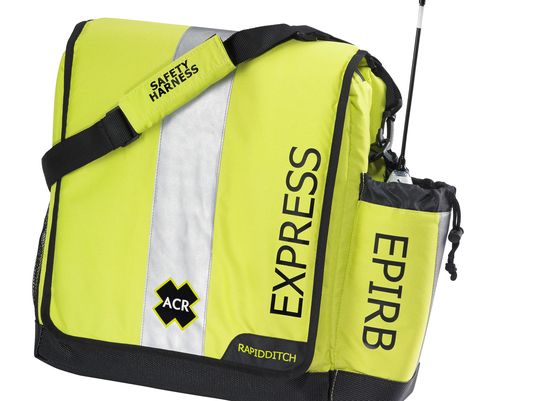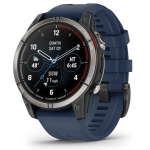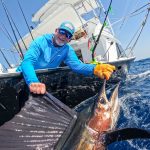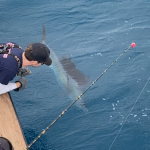Article Courtesy: Florida Today | By: Ted Lund | Originally Published Aug 1, 2015 | Please click here for original article.
Above: The ARC Express ditch bag is buoyant, water-resistant and has plenty of pockets, zips and straps to hold important abandon ship gear, including an external pocket that gives you instant access to your EPIRB signaling device.
If you’ve ever spent any time on — or in — the water, you learn pretty quickly that the ocean is an incredibly vast expanse. But it really hits home if you take to the air and survey the places you normally fish, dive and boat.
That lesson was driven home several years ago while attempting to locate a dead sperm whale floating off Key West. It was 35 feet long and literally covered with giant tiger sharks. We knew its last location at sundown the day before, and a good friend and fishing buddy, Paul DePoo, owner of Island City Flying Service, offered me the use of a plane and pilot in hopes of finding and photographing the melee.
After three hours covering hundreds of square miles, we gave up. By 10 a.m. the next day, the carcass had drifted to the west — nearly 40 miles along the reef — and ended up aground in the Dry Tortugas.
The lesson?
Finding a bloated, 35-foot-long whale carcass being devoured by sharks is like finding a needle in a haystack. Finding a person, floating without a boat — is exponentially more difficult.
Randy Vance is an avid Central Florida Boater and author of “Boating for Dummies” (http://bit.ly/1DVOrvD) and calls Canaveral his home port.
“In this day and age, with the technology developing and costs coming down, there’s no reason to leave the dock without some basic safety gear that can really help if things take a turn for the worse,” Vance says.
The term is a ditch bag, and the first thing you need is the bag itself. A number of manufacturers like ACR make specific bags for the purpose. Most are made of high-visibility Cordura (durable synthetic fabric) with reflective strips on them. The idea is to have all of your gear in one compact, rugged bag so that if you do have to leave the boat quickly, you can do so.
Once you’ve settled on a bag, you’ll need to look at the additional contents. They can be broken down into several categories: signaling, tools, documents and utilities.
Signaling is probably the most important category, and you’ll want to consider at least a personal locator beacon (PLB) or electronic position indicator radio beacon (EPIRB). Although both work by sending a coded message via the 406 MHz distress frequency, which is then relayed via the Cospas-Sarsat global satellite system, EPIRBs also broadcast on a second frequency as well. But there are some differences that boaters need to be aware of.
First, an EPIRB is registered to a vessel, whereas a PLB is designed to be carried on your person. Some, like the SPOT Gen 3 ($99; www.findemespot.com) are smaller than a modern cell phone. An EPIRB, like ACR’s Global Fix Pro ($499; www.acrarcatex.com), is usually installed to automatically deploy if a boat sinks, whereas PLBs can be activated with a touch of a button.
Usually, a PLB has a battery life of about 24 hours, as opposed to the minimum 48 hours of an EPIRB. Because a PLB is designed to be carried on your person, it broadcasts a second signal to help local search and rescue teams zero in. In either case, these electronic marvels are your best chance of sending your location directly to rescue authorities.
A waterproof radio is probably the second-most important item. Radios like the Standard Horizon HX870 ($299; www.standardmarine.com) or ICOM IC-M36 ($199; www.icom.com) are millitary standard waterproof, have instant access to VHF channels 9 and 16 and will allow you to hail search teams as they close in. Other signaling options include a signal mirror, whistle or air horn, as well as traditional or LED flares.
Tools can come into play if stranded for a long time. A good place to start is with matches or a lighter, as well as a candle. Other important additions are a knife or a good multi-tool with a variety of blades and screwdrivers. Another possibility is a prepackaged fishing kit with basic hooks, line, lures and even a bait like Berkley Gulp! that can sit for years in the packaging and still be effective if needed.
One thing often overlooked are documents. You’ll definitely want to have copies of your vessel’s registration, any fishing licenses or other documents such as photo IDs, passports or anything else that can provide information to rescuers. If you have a logbook on the boat showing where you’ve been, where you are going and what the conditions are, it’s a good idea to grab that as well. And you’ll want a separate waterproof bag that is big enough to put it all in and keep it secure, including those of your captain and crew.
With regards to utilities, it’s a good idea to have some spare bottles of water, and possibly an MRE ration or two, especially if boating far from shore. SPF 30 sunscreen as well as possibly several lightweight sun masks and a basic first aid kit are all good bets.
“No bag can ever really be complete,” Vance says. “But you can add and subtract items based on where you’ll be boating, distance from shore and even the number of days your planning for your trip.”
Mitchell Roffer, the Melbourne-based oceanographer who has been helping map out possible ocean current scenarios, has a couple of other recommendations as well.
“One thing I would really recommend is either a dye packet that disperses in the water or a smoke canister,” Roffer says. “Anything to help elevate your visibility to rescuers. Because the ocean is a really, really big place and you are really, really hard to see.”






